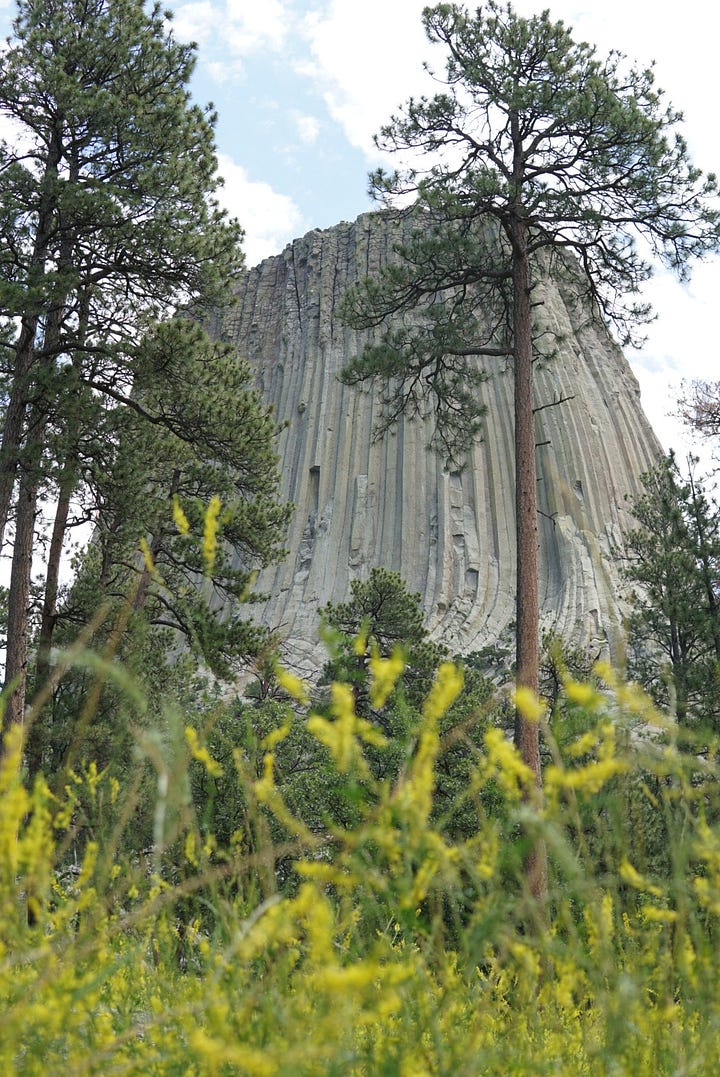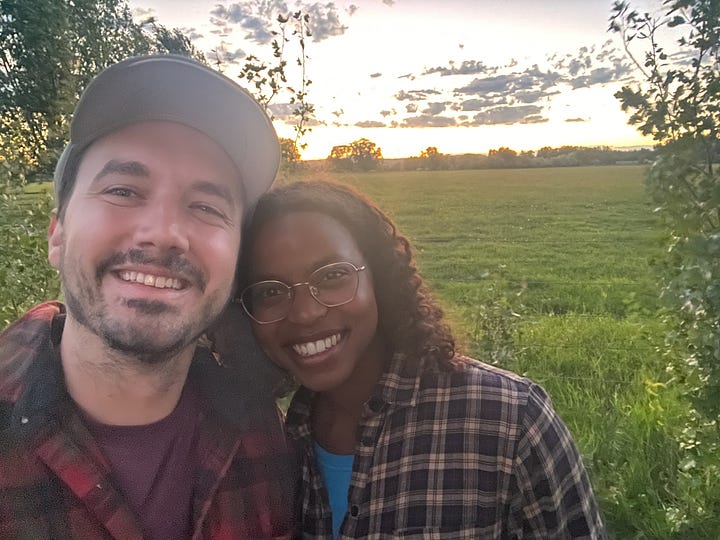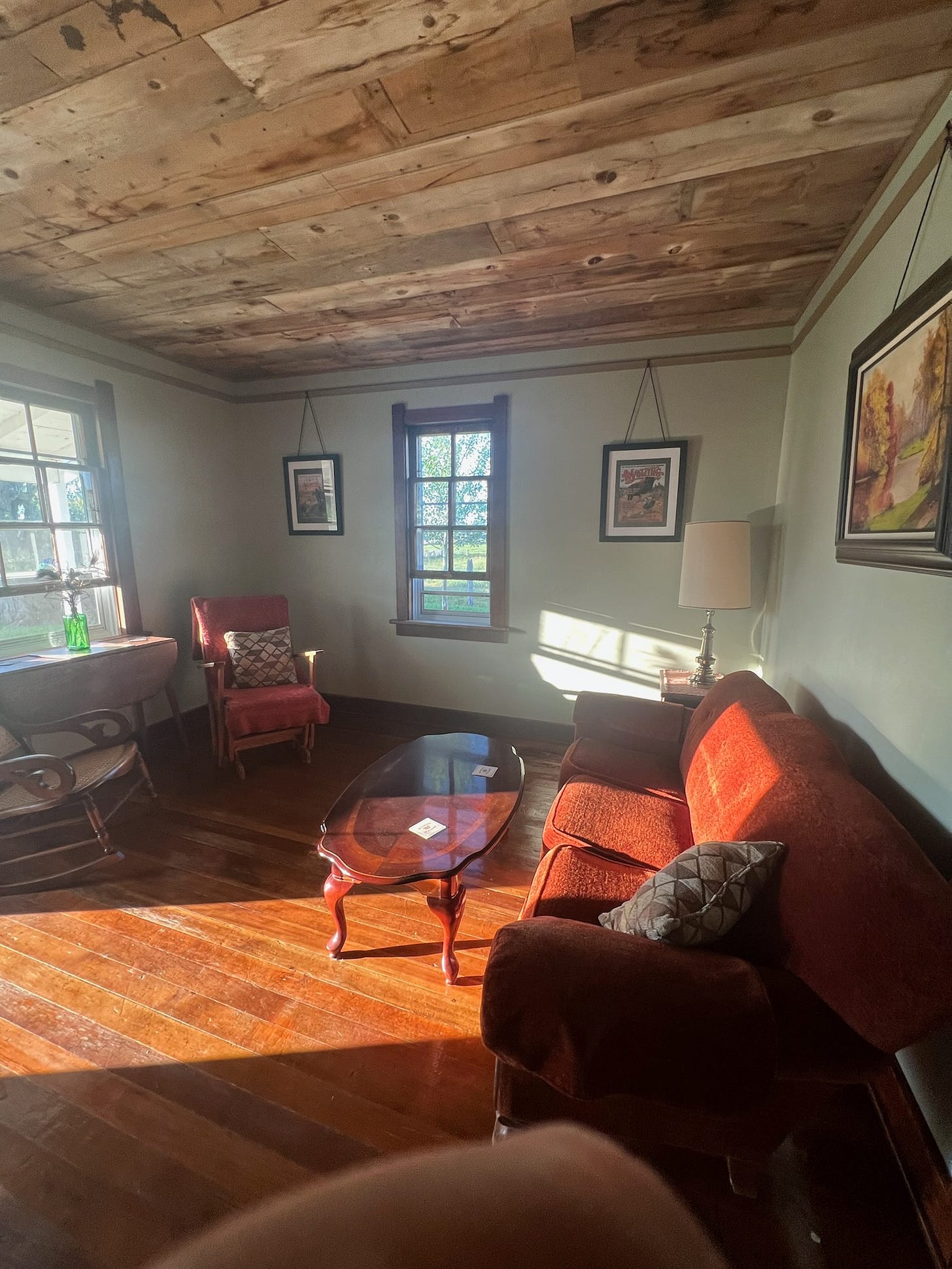From South Dakota, we continued west into Wyoming. We decided to stop at a national monument (America’s first national monument actually, designated in 1906 by Teddy Roosevelt) called Devil’s Tower. It is a round, mountain-like structure that seems randomly plopped down amid flat grasslands. The top looks satisfyingly smooth like when you slice or cut a hunk of clay. Juxtaposed against the smooth top are deep grooves all around the perimeter. Several Indigenous tribes have sacred narratives or oral histories about this site, many of which involve a large bear dragging its claws along the mountain’s edge (making the ridges).


We walked around the base of the monument to stretch our legs and see it up close. We walked passed several prayer flags of different colors and natures (ribbons, bandanas, homemade satchels) tied to tree branches. During one part of the year, the park asks non-Indigenous people to consider visiting another time so that certain communities can have privacy in spiritual practices. It was yet another place where I felt an overwhelming connectedness to the Earth and a greater spiritual power.
From Devil’s Tower we continued on through Eastern Wyoming. No offense to anyone who lives in Eastern Wyoming, but this was the worst part of our drive. Mining, fossil fuel industries, and big agriculture has destroyed much of the land. Dotted along the highways are makeshift towns to support mining – many of which seemed void of people living there anymore. We stopped at a McDonald’s for lunch (we did this only twice in our whole Boston to Seattle stretch!) and Eastern Wyoming’s only redeeming quality came in the form of a very nice old woman who went out of her way to chat with us about travels and make a few jokes while she took our order (which ‘accidentally’ did not include my sweet iced tea on the bill).
A few hours later we arrived in Riverton, Wyoming on a farm right outside of the Wind River reservation. Cole found this farm stay on AirBnB and we thought it would be a nice “treat” after a week of sleeping in a tent. While it was a treat, it was as rustic as advertised — complete with an outhouse, outdoor shower that only got a bit warm, and gently encouraged farm duties. But hey! It beats a random hotel in Eastern Wyoming that’s for sure.
The farm was a 120-acre tract literally from the Homestead act that this family (Steve, Joanne, and their two daughters) bought 15 years ago. The farm is a family-run operation with a chicken coop, small meat processing station, vegetable garden and greenhouse, and a general store in town where they sell their own products and support 15-20 small farmers and local artisans to do the same. Steve started his career in the U.S. Coast Guard, which brought him all over the country. Farming is his “retirement” job.
The guest home we stayed in still has the original flooring of the first home built on the property in the 1800s, which Morgan (one of the daughters) shared with us is a testament to the homesteader who first made his way out to the middle of Wyoming, likely with not much to his name and an aspiration to tame the land and build a life for himself. Their family had no connection to this original homesteader and I was struck by the pride and admiration with which she told this story – the tale of the American pioneer forging his own way in wild land. The Homestead Act, which gifted these 120-acres to this pioneer, was likely land taken from Native American tribes in the region. (As Cole mentioned in an earlier blog post, the homestead act primarily benefited white people both American and immigrant and resulted in transferring more than 270 million acres of land into private ownership).
The irony of this land being on the edge of the Wind River reservation, land of the Eastern Shoshone and Northern Arapaho tribes was not lost on me. An 1863 treaty called for the tribes in this Wyoming region to be contained within 43 million acres. This was cut to 2.3 million acres over the following 70 years as more white pioneers sought land of their own (source). As Morgan shared the history of the home with me, I wondered how much of this history she knew, believed, or thought did or did not apply to this particular person and story. I also pushed myself to see how yes, it was a dangerous and difficult feat to survive in these conditions and make a home out west, and maybe there is something beautiful about that or could be, but not at the expense of ignoring certain parts of our past. How do we hold both of these stories? Who has a right to a land and a place? How can we acknowledge and learn from America’s sins and promises to create a country we do feel shared pride about?
After settling in, Morgan invited us to harvest our own vegetables from the greenhouse for dinner. I harvested some chard, basil, and cherry tomatoes while Cole boiled some pasta and browned some ground pork, then whipped it all together into yet another delicious meal. We sat in the back of our little house and watched the sunset, birds swooping all around, an occasional “moo” in the distance and talked about maybe getting some land of our own one day. A few acres where we could grow food for ourselves and our community, build a flower garden for the birds and bees, raise chickens, host retreats for people who are also dreaming up a better world, or who just want to reconnect to land in a way that feels comfortable and safe. A place where our families could find respite and if we have children, where they could play free and grow up with a close connection to the Earth.


In the morning, we moved around the cows. This is a central tenet of the regenerative agriculture approach. Instead of using pesticides and other chemicals, we pen the cows in different parts of the farm and their poop fertilizes the soil. This method sequesters carbon in the soil, rebuilding structure that had been lost due to traditional farming methods. We fed the chickens too, including their one pet chicken named Wonky—named as such for his missing eye and twisted beak as a result of what they think was surviving a coyote attack—who lets you hold him like a cat and follows Morgan around as she does all her chores.
Steve and I talked all sorts of politics, the importance of knowing where our food comes from, how big agriculture has decimated small and mid-size farming, and how oil and mining has ruined farmlands in the area (and across the globe) and taken jobs. He taught us about the Food Freedom Act, which he was instrumental in organizing around in Wyoming. This act allows farmers to sell directly to the consumer. Big Ag, with its perennial bipartisan support, is responsible for much of the regulation that makes a small farm like this economically inviable. Steve pointed out that 80% of all beef in America is controlled by just four companies and that a small farmer using traditional methods, like his neighbor, would need about $3 million in capital to make an annual salary of roughly $60,000. These stats are not accidents, as we’d discover through our own research. It has been proven that the U.S. government conspired with big corn growers to produce highly addictive foods to get Americans to eat more and thus grow our domestic food supply (source). On average, Americans are getting 56% of their food from subsidized crops that are linked to all manner of the things we know are killing us early. Many of these policies are supported by Republicans and Democrats alike and the current U.S. Secretary of Agriculture, Tom Vilsack, is a villain among many regenerative farmers and farmers of color for his reign over decades of well-documented violation of civil rights and racial bias at the U.S. Department of Agriculture (USDA). USDA policies and practices have disproportionately harmed Black farmers, who today own just over 3 million acres of farmland compared to 16 million in 1910, just 47 years after the emancipation proclamation. As recently as 2022, the USDA granted loans to only 36% of Black farmers who applied as compared to 72% of white farmers. (I wrote some more about this at my previous job in a piece here.)
The United States also pays other countries to alter their agricultural practices to round out our supply, contributing to aridification across the Americas. It was Steve’s view that the people fleeing their homeland across the border into the United States, whom he was required to chase down while serving in the U.S. Coast Guard, were most often fleeing their home because there was no way to make a living on a small or medium-sized farm—large multinational companies bought up the land and ruined the farms there too. Steve encouraged us to imagine a better world in which millions of people across the globe were reconnected with small holdings of land and able to compete against the unsubsidized multinational ag corporations. Having seen the bipartisan support for intense farm regulation, he believed that unfettered capitalism was the answer. We were fascinated at how close our aims yet how disparate our means were and we wondered what might bridge this gap.
After farm chores, Johnny (Steve’s grandson in the video above) and I played Pokemon for a bit. We ate some delicious homemade sourdough bread; a sausage, kale, and feta frittata; and washed it all down with a glass of raw milk.
We thanked Steve and Morgan for a wonderful stay. On our way out of town, we stopped by their general store, where Morgan somehow was already behind the cash register after a long, early morning of farm chores. We bought a few food items to take with us in our cooler and met some of the other local folks selling their products there. Steve let us know in his AirBnB review that it was a “real nice touch.” It’s the little things!
While this stay was just one night, as you can tell, it made an impression on me and still has me thinking about the stories we tell and knowing our history, how connecting at an individual level may help us actually understand each other better and give grace to each other, and the craving perhaps we all have in some way or another to reconnect to the land. How do we harness all of that for good?






Another wonderful entry. Loved the photos. And this line, "In the morning, we moved around the cows." Says it all.
I think this is the best one yet. I appreciate the explanation about the Homestead Act. Many Americans are not aware of how millions of acres of land was confiscated from indigenous people, then re-distributed for free to white settlers in the 1800's. Very few, if any, non-white people were given any land to settle. The 40 acres and a mule promise to formerly enslaved had been long broken.Your and Cole's observations give me hope - we can certainly do better.